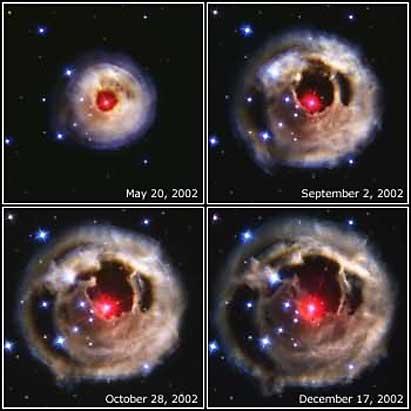Dust expelled by big stars

In January 2002 a constellation star of Unicornus burst, becoming the brightest star of the Milky Way for three months. Three groups of astronomers investigated this explosion using images taken by the Hubble Telescope: one from the United States, one from the Canary Islands and the last from Italy.
At first they thought it was a novel, but the explosion did not leave the traces left by a novel. On the contrary, the star expanded and became a supergiant star. This evolution is not the normal path of evolution of
stars, so it has been a very interesting explosion for astronomers.
In addition, in Hubble's images this supergiant saw clear the process of expanding the "dust bubble". Call attention. And from the data and images collected, researchers have calculated that the star is within 20,000 light-years.
However, physicists want to find an explanation of this striking phenomenon. It is unusual for a star to release so much energy in such a short time. Therefore, all options are now being studied. According to experts, this instant energy can come from two sources: gravitation or thermonuclear reactions. It is possible that the answers are reached by the realization of a three-dimensional map of this layer of dust, and new questions may even emerge.
The video is available on the Hubble website.
Buletina
Bidali zure helbide elektronikoa eta jaso asteroko buletina zure sarrera-ontzian











